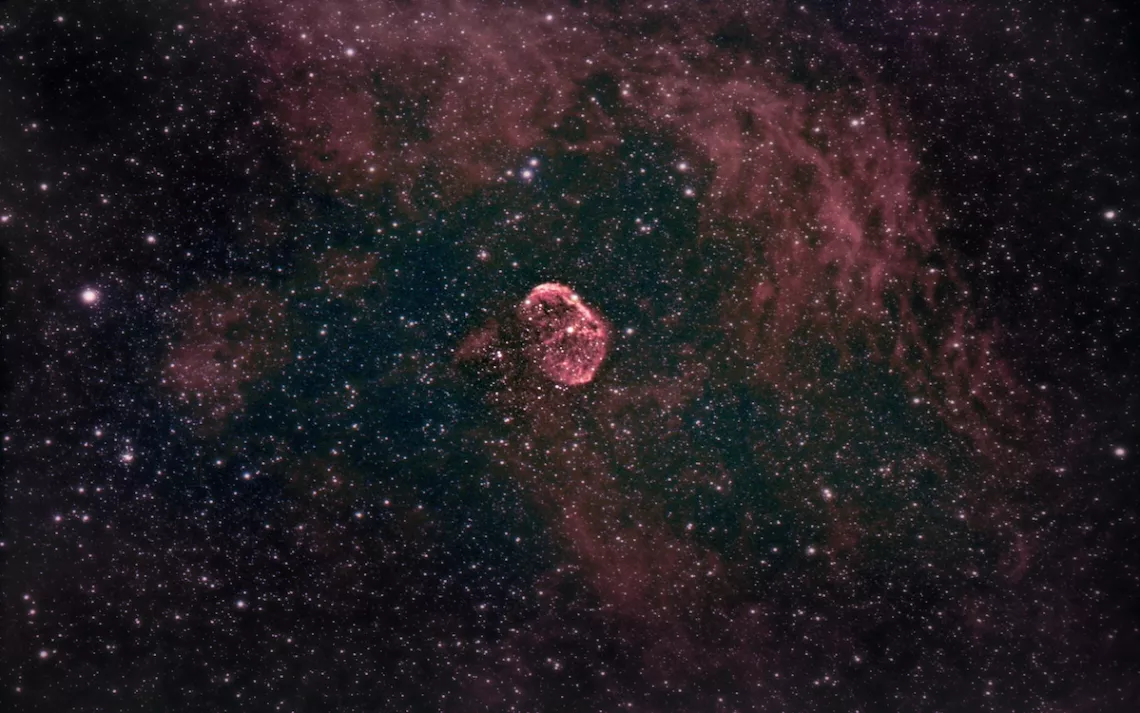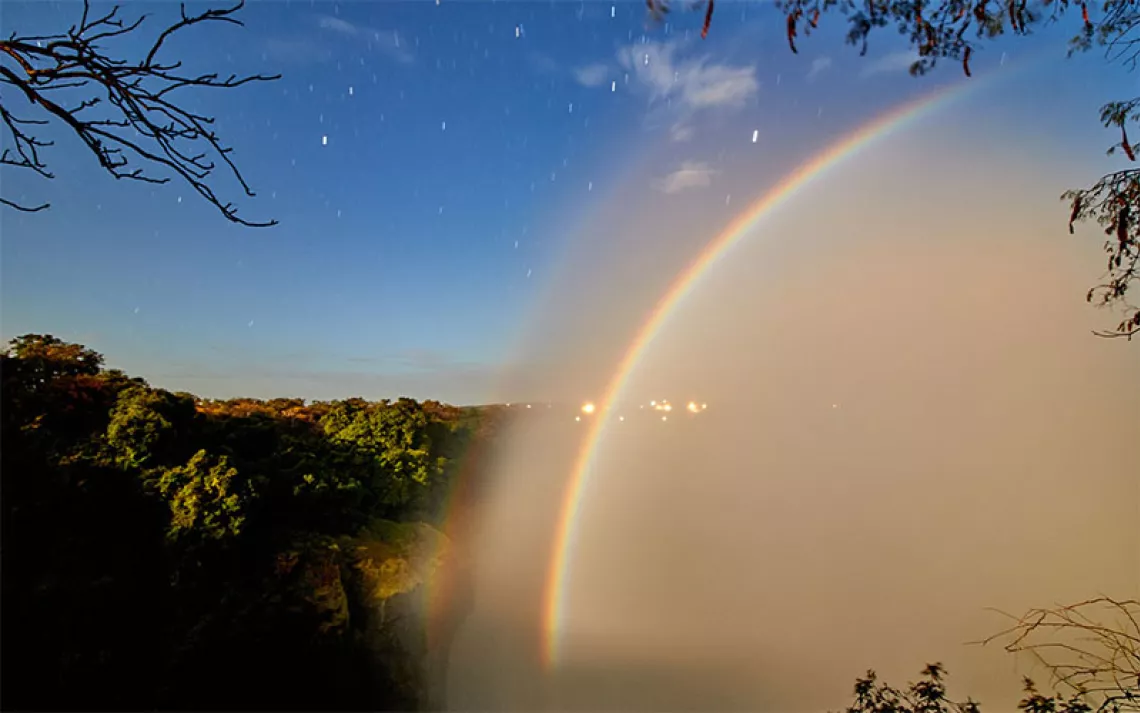July Stargazing: Cosmic Fireworks
Deep space offers a pyrotechnic display that is out of this world

The Crescent Nebula, in the constellation Cygnus, is one of the summer sky’s most stunning cosmic fireworks. | Photo by Jeremy Miller
As I type, loud booms echo in the hills. From my deck, I count at least two dozen backyard fireworks shows in the neighborhoods below. Some of the explosions are surprisingly large, sprouting above the darkened rooflines like shimmering flowers followed seconds later by window-rattling blasts. The backyard displays are nothing new around here. But this year, they’ve been particularly intense as people have sought refuge from the monotony of quarantine by buying up large, commercial-grade fireworks.
As Independence Day approaches, these flickers and reports have me pondering the distant pyrotechnics of deep space, and in particular, the star Betelgeuse, which someday soon may offer up the greatest fireworks display the human race has ever seen.
Located a mere 642 light-years away, Betelgeuse is a bright-red pulsating point of light in the constellation Orion. A member of a class of titanic stars known as red supergiants, Betelgeuse is one of the largest stars we know of, with a girth that is truly mind-blowing. If we were to swap it out for the sun, its outer edge would consume the inner planets, including Earth, and reach beyond the orbit of Mars.
Late last year, astronomers noticed that Betelgeuse had begun acting oddly. In a matter of days, it had dimmed by more than 40 percent. At the same time, its shape had changed from a sphere to something resembling a deflated football. The sudden fluctuations led researchers to believe that Betelgeuse may have entered a stellar death spiral and that a massive explosion, known as a supernova, was imminent.
Supernovae are the culmination of sequential events touched off by the breakdown of the nuclear fusion within the core of a star. When hydrogen fuel in the core is spent, the star loses outward pressure, causing the exterior shells of gas surrounding it to surge suddenly inward. As matter rushes into the core, the star’s gravitational attraction becomes immense—then unstoppable. The core collapses, resulting in a violent explosion. In their wake, these exploded stars leave telltale signs—gaseous nebulae that appear like wisps of pink, blue, and green smoke strewn across the night sky.
Scientists estimate that supernovae occur in the Milky Way roughly once every 50 years. But because our galaxy is very large, the chances of actually seeing a nearby star explode in our lifetime is extremely slim. The brightest supernova in recorded history probably took place more than a thousand years ago, in 1006, near the constellation Centaurus. Astronomers of the age noted that the object could be seen during the day and was bright enough to cast shadows at night. The Egyptian astronomer Ali ibn Ridwan described the object as about three times as large as Venus: “The sky was shining because of its light,” he wrote. “The intensity of its light was a little more than a quarter that of moon light."
Another dazzling supernova took place just a half century later, in 1054 (some believe the date was July 4) when a star in the constellation Taurus blew itself to pieces. Chinese astronomers described the sudden appearance of a bright object as a “guest star” that burned with an eerie and intense yellow hue. Within weeks, the star had faded from view, but the remnants of that explosion can still be seen today through modest-size telescopes. The gaseous contours of the Crab Nebula, one of the most dynamic and intensively studied objects in space, are what remains from the 1054 supernova. Astronomers have observed that the Crab’s characteristic braided clouds—driven outward from the epicenter of the thousand-year-old blast—change on the order of months rather than years.
The odds of seeing a supernova increase greatly when you look beyond the confines of our own galaxy. Astronomers, both professional and amateur, scouring the skies with telescopes, detect hundreds of deep-space detonations per year. Capturing one of these rare events is a near certainty when you consider that there are tens of millions of galaxies scattered throughout space. A recent supernova known as SN2020jfo, discovered in May, strobed to life within an arm of the spiral galaxy M61, located in the galaxy-rich constellation of Virgo. In some cases, a single star gone supernova can outshine the hundreds of millions of stars of the galaxy where they are found.
Supernovae are not mere curiosities. Because the behavior of certain kinds of supernovae, known as type Ia, are surprisingly predictable, these explosions of white dwarf stars have served as an important universal measuring stick. In his book Astrophysics for People in a Hurry, astronomer Neil deGrasse Tyson uses the analogy of “standard candles” as a way to describe how astronomers rely on supernovae to determine the vast distances between galaxies. “Standard candles simplify calculations immensely: Since the [type Ia] supernovas all have the same wattage, the dim ones are far away, and the bright ones are close by.”

Sign up to receive Sierra News & Views
Get articles like this one sent directly to your inbox weekly.
With this action you affirm you want to receive Sierra Club communications and may vote on policy designated by the Sierra Club Board.
And yet, not all supernovae are so uniform. Some are so violently eruptive that they are capable of tearing the fabric of space itself, collapsing upon themselves to form black holes. In April, Harvard researchers announced the discovery of the brightest stellar explosion ever recorded. Supernovae in this class, known as superluminous supernovae, or (SLSN), are more than 10 times brighter than normal supernovae. (The explosion documented by Harvard researchers happened to be 500 times brighter.) Scientists are just beginning to understand the physics behind these overwhelming flashes of light and speculate that they may be triggered by a host of strange phenomena, including extremely dense and magnetically charged neutron stars, called magnetars.
So what are we to make of all these distant flashes of light? To me, supernovae are beacons of change, reminders to a short-lived species that our seemingly fixed universe is, in fact, in a state of constant flux. Cosmic timescales, like those of geology, are “punctuated” (to borrow a term from the great evolutionary scientist Stephen Jay Gould) by cataclysmic events. The slow grinding of tectonic plates gives way to the sudden snap of an earthquake. The steady churn of lava in the belly of a volcano reaches a critical point and becomes an eruption. Human history, too, operates on similar principles. Disparate events flash and catalyze entire movements: The killing of George Floyd in Minneapolis triggers a supernova of protest across the United States, shining light on the structural inequities of an entire nation.
From destruction comes creation. The heavy elements in our bodies—carbon, nitrogen, oxygen—were fused within stars. Those atoms were flung out into the cosmos over millions of years in these massive explosions. As Carl Sagan famously quipped, we are all “star stuff.” I like to think that we are all brothers and sisters of supernovae.
Whether or not Betelgeuse will give us the show of a lifetime anytime soon is uncertain. But it seems unlikely. After its sudden diminution, Betelgeuse began to brighten again, leading researchers to speculate that it was a plume of obscuring dust rather than changes in its core that had caused Betelgeuse to fade. Someday, however—perhaps next year, next century, or a hundred thousand years hence—Betelgeuse will collapse upon itself and explode. Whoever is here on Earth when that happens will witness one hell of a grand finale.
WHAT TO LOOK FOR IN JULY
Because Betelgeuse is a winter star, it is difficult to see at this time of year, rising just above the horizon in the hours before dawn. But another red supergiant, Antares, in the constellation Scorpio, is Betelgeuse’s summertime counterpart and gives us a sense of the chaotic lives of these massive stars as they near the end of their lifespan. Antares is easy to find—a pulsating red star at the “heart” of the scorpion. Through the lens of a camera, Antares is absolutely magnificent, enveloped in massive clouds of multicolored gas and dust known as the Rho Ophiuchi Cloud Complex. Like Betelgeuse, Antares is bound for a supernova in the not-too-distant future, but we can’t say exactly when.
For naked-eye and binocular astronomers, the solar system’s two largest planets, Saturn and Jupiter, make a grand entrance on the eastern horizon this month. These massive gas planets will meet in a rare conjunction, the last of which was seen 20 years ago. Those with telescopes can try to see how many of Jupiter's and Saturn’s moons they can count. While the two planets, collectively, have over 150 moons, only 10 or 11 are visible with consumer-grade telescopes.
This month’s full moon arrives on July 5. Native peoples named it the Buck Moon because it marks the onset of summer, when antlers begin to sprout from the heads of male deer. July’s full moon is also known as the Thunder Moon for the explosive thunderstorms that are common in midsummer. This time of year, I like to ditch the headlamp and use the light of the full moon to negotiate favorite hiking trails. The sight of familiar landmarks rendered silver in moonlight gives the sense of entering a parallel dimension—as if one has entered a quieter counterpart of our increasingly cacophonous world.
 The Magazine of The Sierra Club
The Magazine of The Sierra Club



